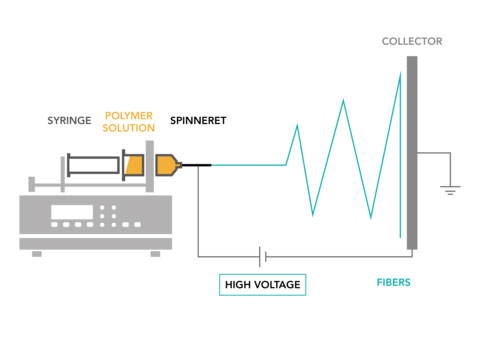Electrospinning mechanism: the basics of the nanofibre creation process
This article will give you an introduction to the basics of the electrospinning mechanism and show you what this innovative process is all about.
What is electrospinning?
Electrospinning mechanism is designed to produce small-diameter fibres over a modest surface area, with relatively simple and inexpensive equipment required.
Electrospinning uses forces produced by a high electric field to achieve the formation of polymer fibres of nanoscale diameters. The electrospinning process begins when electrical forces attract the surface of a polymer solution to form an electrically charged jet. When the jet dries, evaporates or solidifies, electrically charged fibres, called nanofibres (or nanofilaments), are obtained. These nanofibres are collected on collectors of different geometry, the latter chosen according to the desired result.

Electrospinning setup
A typical Electrospinning setup consists mainly of four elements:
- syringe, containing the polymer solution or melt to be electrospun;
- positive displacement pump, which regulates the fluid exiting the syringe;
- high potential voltage generator, connected to the syringe needle via an electrode;
- grounded metal collector, whose function is to collect the fibres, usually, but not always, on an aluminium foil.
Electrospinning mechanism
The electrospinning process is mainly driven by electrostatic forces acting on the surface of a liquid polymer solution or a polymer melt, and this interaction results in the production of fibres. In conventional spinning, the fibre is also subject to:
- tensile forces;
- viscous forces;
- gravitational;
- inertial forces;
- aerodynamic forces.
When free charges in the liquid polymer (usually positive ions) move in response to the electric field, they rapidly transfer a force to the polymer liquid. A strong electric field is then applied to the solution, which generates an electrostatic force greater than the above forces, and the result is the formation of a jet that moves towards the opposite electrode.
A stable jet has four regions:
- the base region: the get emerges from the liquid polymer;
- the jet region: zone through which the jet passes;
- broadening region: area in which the jet splits into many fibres;
- collection region: the last region in which the jet is accumulated.
In the last region, the formed fibres are collected on a collector that can have the geometric shapes of:
- a static plane: with the function of collecting a matrix of disordered fibres;
- a cylindrical geometry: to obtain a more ordered collection depending also on the rotation speed (rpm).
It is possible to directly deposit the electrospun nanofibres on objects of different shapes to obtain three-dimensional nanofibre substrates of controlled shape and size. Various types of electrospun fibre scaffolds aligned or randomly oriented can also be manually processed to obtain the desired geometry.
During the process, the material solution is extruded from the spinneret forming a small droplet; high voltage is required to transfer charge with a certain polarity to the surface of the droplet. When the electric field exceeds a critical value, the repulsive electric forces overcome the surface tension forces and the material is accelerated towards the collector (which has opposite polarity) in the form of a fibre.
In this video uploaded by CanalDivulgación we can see the electtrospinning mechanism.
The three phases of the electrospinning mechanism
The Electrospinning process can be divided into three main phases:
- formation and elongation of the charged jet in the axial direction: during this phase the jet coming out of the spinneret is accelerated by the Coulomb forces which push it towards the collector, acting on the charges carried by the material. The velocity of the jet varies over a range generally from 1 to 15 m/s. At this stage, the meniscus of the solution as it exits the syringe needle deforms into a conical shape known as the Taylor cone;
- growth of the bending instability and further elongation of the jet which may be accompanied by branching and/or splitting of the jet: the diameter of the jet, in the straight part, decreases as the distance from the needle tip increases. The jet becomes very long and thin leading to an increase in the characteristic time required for the excess charge to redistribute itself along the entire jet;
- solidification of the cast into micro/nano fibres and deposition on the collector: the solvent evaporates, leaving a charged polymer fibre. The solid polymer fibres are finally deposited on a collector. During the fibre deposition process, deformation instability may occur due to the longitudinal force of motion hitting a solid flat surface. In particular, the morphology and structure of the deposited fibres are highly dependent on the collection method as well as process parameters such as, for example, the rotation speed of the collector.
The electrospinning mechanism is the future because of its wide range of applications.

